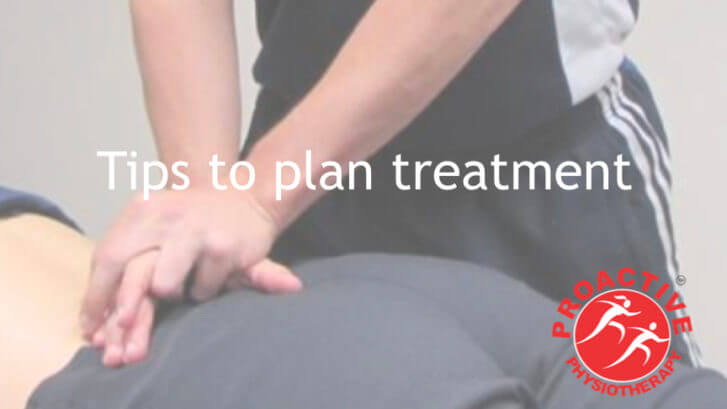Tips to plan the treatment
The subjective examination is the most crucial aspect of the examination as it determines the severity, irritability and nature of the patient’s condition. Good questioning leads to the formation of primary and secondary hypotheses and helps in prognosis of the injury. you should have a solid understanding of the patient’s condition and reduce the risk of missing a pathology. Make a Body Chart: Area of symptoms – must determine each aspect of symptoms for each area
- Location and distribution
- Symptoms – pain, pins & needles, numbness
- Type of pain – ache, burning, throbbing etc
- Constant or intermittent
- Intensity.
Relationship of each symptom or area
- Used to determine diagnosis and prioritising of treatment
What are the aggravating Factors: Essential in determining irritability (a concept described by Geoff Maitland, the degree to which an injury is exacerbated by certain activities)
- Aggravating activity – time to onset, intensity of symptoms, time to ease on ceasing activity
Easing Factors useful in planning treatment . Always ask for 24 Hour Behaviour Valuable in determining an inflammatory condition
- AM – intensity of symptoms, time to ease
- Day – behaviour during day e.g. depends on activity, worse by end of day, better as day goes on.
- PM – painful/comfortable positionstaagsga, time to get to sleep, wake in night, time to return to sleep
Special Questions need to be ask….
- Malaise – feeling of general discomfort, uneasiness, being “out of sorts”
- 5D’s (Cx) – dizziness, dysarthria (speech), dysphagia (swallow), diplopia (vision), drop attacks, assists in determining risk of vertebral artery involvement
- Cord signs – glove and stocking paraesthesia, balance problems
- Cauda equina signs – bowel or bladder changes (urinary retention, unable to control anal sphincter)
- Medications – for pain relief, for other conditions
- General Health – “do you have any other medical conditions?” “how is your general health?”
- Investigations – “have you had or been referred for any scans?”
Current History
- Onset and mechanism of injury
- Behaviour/progression of symptoms since onset
- Treatment since onset
Past History
- Previous occurrences – when, mechanism, previous treatment & response, recovery time
- Previous injuries related to presenting condition
Social History Assists in return to work and return to sport rehabilitation, determines goals of treatment
- Employment – nature of work, hours per week, effect of injury on work status
- Living situation – dependents, home duties, stairs, activities of daily living
- Recreation – level of activity, sessions per week, guides rehabilitation
Goals: it’s crucial to know the patient’s expectations. You may be overestimating or underestimating their desired level of activity. It also helps with understanding the patient’s perspective on their injury and cognitive factors. Questionnaires: Questionnaires can be used to provide valuable information. With a growing awareness about chronic pain , these can provide invaluable information which often missed in a standard assessment. Tips
- The Opening Question…it must be short, direct, and encourage the patient to tell you their issue and be the same with every patient. Here it’s few examples are “Tell me about your problem” “So, what’s the problem?” “How can I help you?” “What can I do for you?
Follow up on answers with further questioning
- Do you wake up in the night, is it pain that wakes you?” “you’re experiencing blurred vision, do you usually wear glasses or have vision problems?”
- When asking about morning pain, ask “how is your pain/symptoms in the morning compared to before you went to sleep?”, this narrows the interview to the pattern of their current pain rather than their 10 year history of aching knees.
- General health…often people say “I’m fine” or “good” when asked about general health.
In summary when when a patient comes to you consider above tips to help in bettter treatment plan. References
- Maitland, G. D. (1991). Peripheral manipulation (3rd ed.). London ; Boston: Butterworth-Heinemann.
- Refshauge, K., & Gass, E. (Eds.). (2004). Musculoskeletal Physiotherapy: Clinical Science and Evidence-Based Practice. Sydney: Butterworth Heinemann.




Leave a Reply
Want to join the discussion?Feel free to contribute!